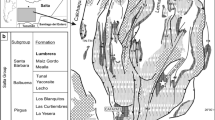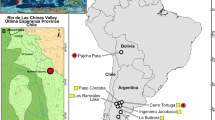Abstract
A new genus and species of eutriconodont mammal, Chaoyangodens lii gen. et sp. nov., from the Dawangzhangzi bed of Yixian Formation, Lingyuan, Liaoning, is reported. The new species has a tooth formula I5-C1-P1-M3/i4-c1-p1-m4, unique among eutriconodonts in having only one premolar in lower and upper jaws, respectively, and a distinctive diastema between the canine and the premolar. Its simple incisors and reduced premolars show a mosaic combination of primitive and derived features. This new taxon adds to the diverse group of Jehol eutriconodonts. Among the known species from at least three horizons, there seems no evolutionary trend in morphology that is recognizable, except for that larger species are all from the Lujiatun bed of the Yixian Fm. A thorough and systematic analysis involving all the Jehol eutriconodonts is needed to understand their phylogenetic relationships.



Similar content being viewed by others
References
Fox RC (1978) Molar structure and function in the Early Cretaceous mammal Pappotherium: evolutionary implications for Mesozoic Theria. Can J Earth Sci 2:412–442
Butler PM (1978) A new interpretation of the mammalian teeth of tribosphenic pattern from the Albian of Texas. Breviora 446:1–27
Smith P, Tchernov E (1992) Structure, function and evolution of teeth. Tel Aviv Freund Publishing House Ltd
Rougier GW, Isaji S, Manabe M (2007) An Early Cretaceous mammal from the Kuwajima Formation (Tetori Group), Japan, and a reassessment of triconodont phylogeny. Ann Carn Mus 76:73–115
Kielan-Jaworowska Z, Cifelli RL, Luo ZX (2004) Mammals from the age of dinosaurs—origins, evolution, and structure. Columbia University Press, New York
Rougier GW, Wible JR, Hopson JA (1996) Basicranial anatomy of Priacodon fruitaensis (Triconodontidae, Mammalia) from the Late Jurassic of Colorado, and a reappraisal of mammaliaform interrelationships. Am Mus Novit 3183:1–38
Cifelli RL, Wible JR, Jenkins FA Jr (1998) Triconodont mammals from the Cloverly formation (Lower Cretaceous), Montana and Wyoming. J Vert Paleontol 18:237–241
Kielan-Jaworowska Z, Dashzeveg D (1998) Early Cretaceous amphilestid (“triconodont”) mammals from Mongolia. Acta Palaeontol Pol 43:413–438
Rougier GW, Novacek MJ, McKenna MC et al (2001) Gobiconodonts from the Early Cretaceous of Oshih (Ashile), Mongolia. Am Mus Novit 3348:1–30
Luo ZX, Chen PJ, Li G et al (2007) A new eutriconodont mammal and evolutionary development of early mammals. Nature 446:288–293
Meng J, Wang YQ, Li CK (2011) Transitional mammalian middle ear from a new Cretaceous Jehol eutriconodontan. Nature 472:181–185
Owen R (1871) Monograph of the fossil Mammalia of the Mesozoic formations. Lond Paleont Soc 24:115
Simpson GG (1928) A catalogue of the Mesozoic Mammalia in the Geological Department of the British Museum. Oxford University Press, London
Simpson GG (1929) American Mesozoic Mammals. Memoirs of Peabody Museum of Yale University 3:1–171
Kermack KA (1963) The cranial structure of the triconodonts. Phils Trans R Soc Lond 246:83–103
Patterson B (1956) Early Cretaceous mammals and the evolution of mammalian molar teeth. Fieldiana Geol 13:1–105
Slaughter RH (1969) Astroconodon, the Cretaceous triconodont. J Mamm 50:102–117
Fox RC (1969) Studies of Late Cretaceous vertebrates (III) a triconodont mammal from Alberta. Can J Zool 47:1253–1256
Rasmussen TE, Callison G (1981) A new species of triconodont mammal from the Upper Jurassic of Colorado. J Paleontol 55:628–634
Krusat G (1989) Isolated molars of a triconodont and a symmetrodont (Mammalia) from the uppermost Jurassic of Portugal. Berliner Geowiss Abhand 106:277–289
Zhou MZ, Cheng ZW, Wang YQ (1991) A mammalian lower jaw from the Jurassic of Lingyuan, Liaoning. Vert PalAs 29:165–175
Sigogneau-Russell D (1995) Two possibly aquatic triconodont mammals from the Early Cretaceous of Morocco. Acta Palaeontol Pol 40:149–162
Cifelli RL, Madsen SK (1998) Triconodont mammals from the medial Cretaceous of Utah. J Vert Paleontol 18:403–411
Godefroit P, Guo DY (1999) A new amphilestid from the Early Cretaceous of Inner Mongolia (P.R. China). Bull l’Inst R Sci Nat Belgique 69(Supplement B):7–16
Ji Q, Luo ZX, Ji SA (1999) A Chinese triconodont mammal and mosaic evolution of the mammalian skeleton. Nature 398:326–330
Li JL, Wang Y, Wang YQ et al (2000) A new family of primitive mammal from the Mesozoic of western Liaoning, China. Chin Sci Bull 45:2545–2549 (in Chinese)
Hu YM, Meng J, Li CK et al (2005) Large Mesozoic mammals fed on young dinosaurs. Nature 433:149–153
Li CK, Hu YM, Wang YQ et al (2003) A new species of Gobiconodon (Triconodonta, Mammalia) and its implication for the age of Jehol Biota. Chin Sci Bull 48:1129–1134
Yuan CX, Xu L, Zhang XL et al (2009) A new species of Gobiconodon (Mammalia) from western Liaoning, China and its implication for the dental formula of Gobiconodon. Acta Geol Sin Engl 83:207–211
Meng J, Hu YM, Wang YQ et al (2005) A new gobiconodont species (Mammalia) from the Early Cretaceous Yixian Formation of Liaoning, China. Vert PalAs 43:1–10
Meng J, Hu YM, Wang YQ et al (2006) The mammal fauna in the Early Cretaceous Jehol Biota: implications to diversity and biology of Mesozoic mammals. Geol J 41:439–463
Smith PE, Evensen NM, York D et al (1995) Dates and rates in ancient lakes: 40Ar-39Ar evidence for an Early Cretaceous age for the Jehol Group, Northeast China. Can J Earth Sci 32:1426–1431
Swisher CC, Wang YQ, Wang XL et al (1999) Cretaceous age for the feathered dinosaurs of Liaoning, China. Nature 398:58–61
Swisher CCIII, Wang XL, Zhou ZH et al (2002) Further support for a Cretaceous age for the feathered-dinosaur beds of Liaoning, China: new 40Ar-39Ar dating of the Yixian and Tuchengzi formations. Chin Sci Bull 47:135–138
Hu YM, Wang YQ (2002) Sinobaatar gen. nov.: first multituberculate from the Jehol Biota of Liaoning, Northeast China. Chin Sci Bull 47:933–938
Li G, Luo ZX (2006) A Cretaceous symmetrodont therian with some monotreme-like postcranial features. Nature 439:195–200
Luo ZX, Ji Q, Wible JR et al (2003) An early Cretaceous tribosphenic mammal and metatherian evolution. Science 302:1934–1940
Ji Q, Luo ZX, Yuan CX et al (2002) The earliest known eutherian mammal. Nature 416:816–822
Wang YQ, Hu YM, Meng J et al (2001) An ossified Meckel’s cartilage in two Cretaceous mammals and origin of the mammalian middle ear. Science 294:357–361
Meng J, Hu YM, Wang YQ et al (2003) The ossified Meckel’s cartilage and internal groove in Mesozoic mammaliaforms: implications to origin of the definitive mammalian middle ear. Zool J Lin Soc 138:431–448
Gao CL, Wilson GP, Luo ZX et al (2010) A new mammal skull from the Lower Cretaceous of China with implications for the evolution of obtuse-angled molars and ‘amphilestid’ eutriconodonts. Proc R Soc B 277:237–246
Crompton AW (1974) The dentitions and relationships of the southern African Triassic mammals, Erythrotherium parringtoni and Megazostrodon rudnerae. Bull Brit Mus Nat Sci 24(Supplement 3):399–437
Fox RC (1976) Additions to the mammalian local fauna from the upper Milk River Formation (Upper Cretaceous), Alberta. Can J Earth Sci 13:1105–1118
Lillegraven JA, Kielan-Jaworowska Z, Clemens WA (1979) Mesozoic mammals: the first two-thirds of mammalian history. California University Press, Berkeley
Kusuhashi N, Hu YM, Wang YQ et al (2009) New triconodontids (Mammalia) from the Lower Cretaceous Shahai and Fuxin formations, northeastern China. Geobios 443:1–17
Averianov AO, Skutschas PP, Lopatin AV et al (2005) Early Cretaceous mammals from Bol’shoi Kemchug 3 locality in West Siberia, Russia. Russ J Theriol 4:1–12
Averianov AO, Lopatin AV (2011) Phylogeny of triconodonts and symmetrodonts and the origin of extant mammals. Doklady Biol Sci 436:32–35
Acknowledgments
We thank En-Pu Gong (Northeastern University, Liaoning), Hai-Jun Li (Jizantang Paleontological Museum, Liaoning Province), and Lian-Hai Hou (Institute of Vertebrate Paleontology and Paleoanthropology, Chinese Academy of Sciences, Beijing) for their field assistance, specimen collecting, and discussion during the course of the study; Shu-hua Xie (IVPP) for specimen preparation. The manuscript was improved by anonymous comments. The study has been supported by the National Basic Research Program of China (2012CB821906), Public Science and Technology Research Funds Projects of Land and Resources (201311120), the National Natural Science Foundation of China (41202014) and the American Museum of Natural History, New York.
Author information
Authors and Affiliations
Corresponding author
About this article
Cite this article
Hou, S., Meng, J. A new eutriconodont mammal from the early Cretaceous Jehol Biota of Liaoning, China. Chin. Sci. Bull. 59, 546–553 (2014). https://doi.org/10.1007/s11434-013-0088-2
Received:
Accepted:
Published:
Issue Date:
DOI: https://doi.org/10.1007/s11434-013-0088-2




